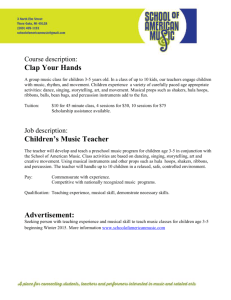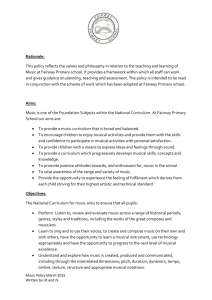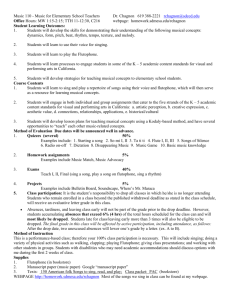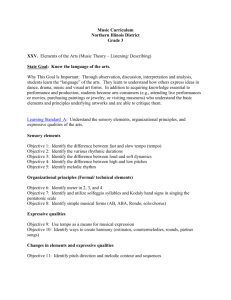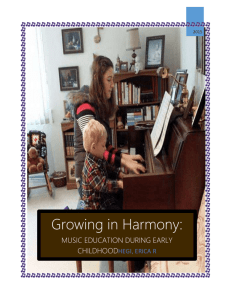Christ Episcopal School Music Overview
advertisement
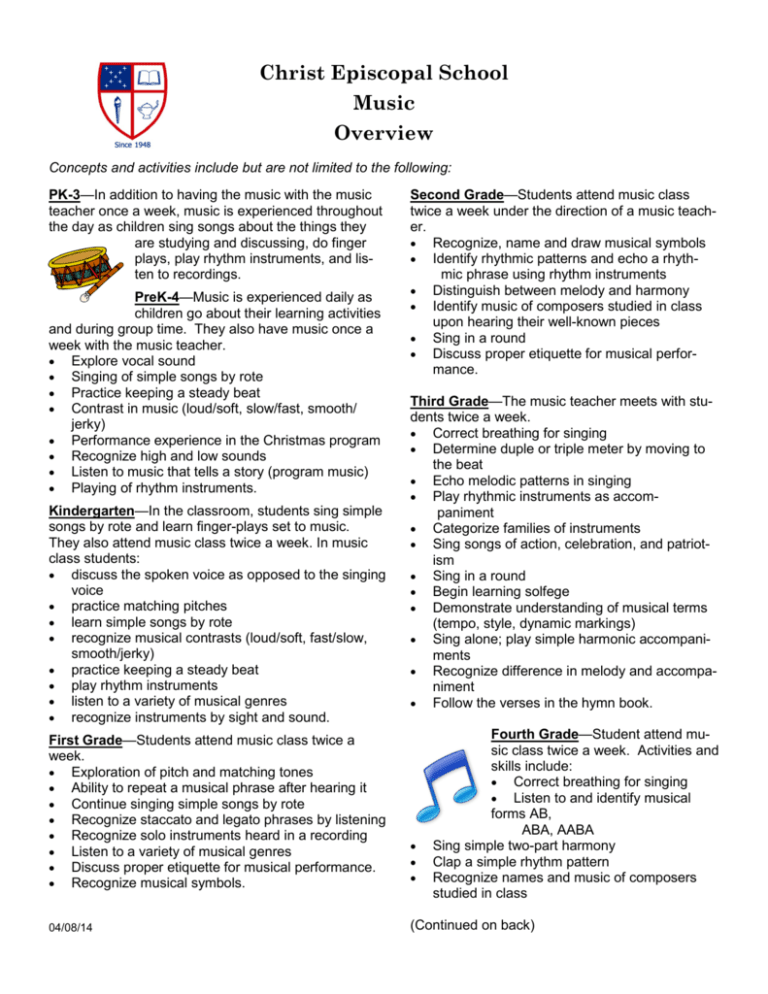
Christ Episcopal School Music Overview Concepts and activities include but are not limited to the following: PK-3—In addition to having the music with the music teacher once a week, music is experienced throughout the day as children sing songs about the things they are studying and discussing, do finger plays, play rhythm instruments, and listen to recordings. PreK-4—Music is experienced daily as children go about their learning activities and during group time. They also have music once a week with the music teacher. Explore vocal sound Singing of simple songs by rote Practice keeping a steady beat Contrast in music (loud/soft, slow/fast, smooth/ jerky) Performance experience in the Christmas program Recognize high and low sounds Listen to music that tells a story (program music) Playing of rhythm instruments. Kindergarten—In the classroom, students sing simple songs by rote and learn finger-plays set to music. They also attend music class twice a week. In music class students: discuss the spoken voice as opposed to the singing voice practice matching pitches learn simple songs by rote recognize musical contrasts (loud/soft, fast/slow, smooth/jerky) practice keeping a steady beat play rhythm instruments listen to a variety of musical genres recognize instruments by sight and sound. First Grade—Students attend music class twice a week. Exploration of pitch and matching tones Ability to repeat a musical phrase after hearing it Continue singing simple songs by rote Recognize staccato and legato phrases by listening Recognize solo instruments heard in a recording Listen to a variety of musical genres Discuss proper etiquette for musical performance. Recognize musical symbols. 04/08/14 Second Grade—Students attend music class twice a week under the direction of a music teacher. Recognize, name and draw musical symbols Identify rhythmic patterns and echo a rhythmic phrase using rhythm instruments Distinguish between melody and harmony Identify music of composers studied in class upon hearing their well-known pieces Sing in a round Discuss proper etiquette for musical performance. Third Grade—The music teacher meets with students twice a week. Correct breathing for singing Determine duple or triple meter by moving to the beat Echo melodic patterns in singing Play rhythmic instruments as accompaniment Categorize families of instruments Sing songs of action, celebration, and patriotism Sing in a round Begin learning solfege Demonstrate understanding of musical terms (tempo, style, dynamic markings) Sing alone; play simple harmonic accompaniments Recognize difference in melody and accompaniment Follow the verses in the hymn book. Fourth Grade—Student attend music class twice a week. Activities and skills include: Correct breathing for singing Listen to and identify musical forms AB, ABA, AABA Sing simple two-part harmony Clap a simple rhythm pattern Recognize names and music of composers studied in class (Continued on back) Music Overview continued Fourth Grade cont. Recall major events from the lives of composers studied Echo melodic patterns after hearing Recognize solo instruments in recordings Discuss proper etiquette for musical performance Play recorders Recognize major musical works Simple rhythmic and melodic dictation Recognize letter names of notes on the staff Sing a major scale on solfege with hand signs Orff instruments-play simple harmonic accompaniment. Fifth Grade—Students attend music class twice a week. Correct breathing for singing Distinguish between major and minor chords Know the names of the composers whose music is sung in class Understand musical terms: opera, oratorio, symphony, concerto, string quartet, and theme and variation Characteristics of Classical and Romantic music Sing simple two-part harmony Clap rhythmic patterns Echo melodic patterns after being heard Recognize solo instruments in recordings Rhythmic and melodic dictations Letter names of notes on treble and bass clefs Discuss proper etiquette for musical performance Play choir chimes Play simple harmonic accompaniments on Orff instruments Follow verses in hymnal Sing minor scale on solfege with hand signs Write patterns in 3/4, 4/4, and 2/4 time Identify key signatures (circle of fifths). 04/08/14 Sixth Grade—Students meet with the music teacher twice a week. Recall major events from the lives of composers studied in class Echo melodic patterns after hearing them Recognize solo instruments in recordings Characteristics from Renaissance and Impressionist periods Recognize major musical works Rhythmic and melodic dictation Compose simple melodies Write rhythms in 3/4, 4/4, 2/4, 6/8, and 2/2 Demonstrate knowledge of musical terms associated with the writing of music Discuss proper etiquette for musical performance Identify key signatures (Circle of Fifths) Correct breathing for singing.

